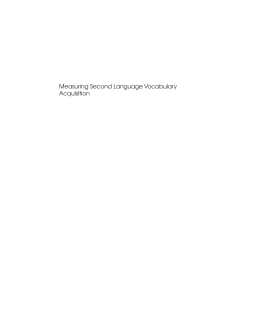
Additional Information
Book Details
Abstract
Measuring Second Language Vocabulary Acquisition provides an examination of the background to testing vocabulary knowledge in a second language and in particular considers the effect that word frequency and lexical coverage have on learning and communication in a foreign language. It examines the tools we have for assessing the various facets of vocabulary knowledge such as aural and written word recognition, the link with word meaning, and vocabulary depth. These are illustrated and the scores they produce are demonstrated to provide normative data. Vocabulary acquisition from course books and in the classroom in examined, as is vocabulary uptake from informal tasks. This book ties scores on tests of vocabulary breadth to performance on standard foreign language examinations and on hierarchies of communicative performance such as the CEFR.
This volume represents a much needed update on issues in assessing vocabulary. It displays the empirical grounding and rigor that only an established scholar like James Milton can provide. A refreshing aspect of the book is that the author questions even the most basic preconceived notions that scholars and teacher practitioners might have about what it means to know a word and to assess this knowledge, and that he reports on the results of his inquiry in an honest and even-handed way.
Andrew Cohen, Second Language Studies, University of Minnesota, USA
In this volume, Milton meticulously connects research on corpus linguistics, SLA, and testing and advocates for establishing reliable units of measurement of vocabulary size as a cornerstone to furthering understanding of second-language (L2) vocabulary development...Throughout this cutting-edge volume, Milton highlights pedagogical, methodological, and theoretical implications while also cautiously reminding readers of intervening factors in establishing connections between vocabulary frequency with vocabulary knowledge.
Diana Pulido, University of Texas at Austin published in SSLA issue 33:3
James Milton worked in Nigeria and Libya before coming to Swansea University where he established the Centre for Applied Language Studies and the Department of Applied Linguistics. His research and teaching focuses principally on vocabulary acquisition and measurement in foreign languages. This research is combined with commercial EFL textbook writing. Recent books include Modelling and Assessing Vocabulary Knowledge and Studies in First and Second Language Vocabulary Acquisition.
This book tackles the ever-intriguing, yet often staggeringly underestimated subject of measuring second language vocabulary development. By adeptly coalescing the second language acquisition theory with the state-of-the-art vocabulary research, along with an original evaluation of the position of vocabulary in general language assessment, Milton convincingly demonstrates the weight vocabulary [measurement] carries in foreign language learning and teaching. Written in a wonderfully systematic and appealingly reader-friendly way, this volume is an especially valid contribution to the field, as well as an indisputable resource and guide for all those interested in exploring any aspect of foreign language vocabulary development.
Visnja Pavicic-Takac, Faculty of Philosophy, J. J. Strossmayer University in Osijek, Croatia
Table of Contents
| Section Title | Page | Action | Price |
|---|---|---|---|
| Contents | v | ||
| Introduction | 1 | ||
| Chapter 1 Explanations and Definitions | 6 | ||
| Chapter 2 Word Difficulty, Word Frequency and Acquisition: Lexical Profiles | 22 | ||
| Chapter 3 Frequency and Coverage | 44 | ||
| Chapter 4 Measuring Vocabulary Breadth: Passive Recognition Vocabulary | 71 | ||
| Chapter 5 Measuring Other Aspects of Vocabulary Breadth | 92 | ||
| Chapter 6 Measuring Productive Vocabulary Knowledge | 117 | ||
| Chapter 7 Measuring Vocabulary Depth | 148 | ||
| Chapter 8 Vocabulary Acquisition and Assessments of Language Level | 170 | ||
| Chapter 9 Vocabulary Acquisition and Classroom Input | 193 | ||
| Chapter 10 Vocabulary Acquisition and Informal Language Input | 218 | ||
| Chapter 11 Implications for Learning and Teaching: Theory and Practice | 238 | ||
| Appendix 1 | 253 | ||
| Appendix 2 | 261 | ||
| References | 262 | ||
| Index | 275 |
